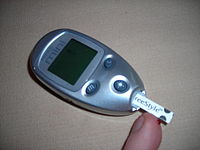
Photo from wikipedia
Introduction Hypoglycemia is frequently encountered in the emergency department (ED) and has potential for serious morbidity. The incidence and causes of iatrogenic hypoglycemia are not known. We aim to describe… Click to show full abstract
Introduction Hypoglycemia is frequently encountered in the emergency department (ED) and has potential for serious morbidity. The incidence and causes of iatrogenic hypoglycemia are not known. We aim to describe how often the cause of ED hypoglycemia is iatrogenic and to identify its specific causes. Methods We included adult patients with a chief complaint or ED diagnosis of hypoglycemia, or an ED glucose value of ≤70 milligrams per deciliter (mg/dL) between 2009–2014. Two independent abstractors each reviewed charts of patients with an initial glucose ≤ 50 mg/dL, or initial glucose ≥ 70 mg/dL with a subsequent glucose ≤ 50 mg/dL, to determine if the hypoglycemia was caused by iatrogenesis. The data analysis was descriptive. Results We reviewed the charts of 591 patients meeting inclusion criteria. Of these 591 patients, 99 (17%; 95% confidence interval, 14–20%) were classified as iatrogenic. Of these 99 patients, 61 (61%) cases of hypoglycemia were caused by insulin administration and 38 (38%) were caused by unrecognized malnutrition. Of the 61 patients with iatrogenic hypoglycemia after ED insulin administration, 45 and 15 patients received insulin for hyperkalemia and uncomplicated hyperglycemia, respectively. One patient received insulin for diabetic ketoacidosis. Conclusion In ED patients with hypoglycemia, iatrogenic causes are relatively common. The most frequent cause was insulin administration for hyperkalemia and uncomplicated hyperglycemia. Additionally, patients at risk of hypoglycemia in the absence of insulin, including those with alcohol intoxication or poor nutritional status, should be monitored closely in the ED.
Journal Title: Western Journal of Emergency Medicine
Year Published: 2019
Link to full text (if available)
Share on Social Media: Sign Up to like & get
recommendations!